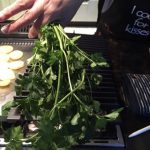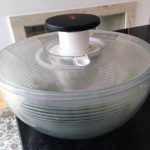Julia George cook-along Zoom meeting on 17th March 2021.
To make our signature Red Trouser Day Moussaka dish the way Julia’s Cypriot family made we’ve put the recipe below, and if you need detailed instructions the video of Zoom cook-in is also on this page.
Once you’ve made it we’re sure you’ll it’ll become a firm family favourite and you’ll enjoy it for years to come.
If you appreciate this recipe please don’t forget to share or join out YouTube channel to find out the latest events from RTD.
Dear Friends,
Here goes – I have only ever just watched Mum make this and now, when I make it, without her, I don’t normally really measure anything – just as she never did. So, please vary the ingredients and amounts to your own taste. In particular, I use little or no added salt in my seasoning, relying on ground black pepper, Worcester sauce, tabasco, wine and herbs. I do use stock, that I have either made myself (I keep some in the freezer) or from a stock cube (I hardly ever use the whole cube) or left-over homemade gravy from a lamb roast to add seasoning, so please season, as we cook, as you would normally do to your own taste.
As I am sure the cooks amongst you – and I know there are many – know, Moussaka is an assembly of fresh ingredients cooked in 3 stages before it is put in the oven to bring it all together in a harmonious single delicious dish. It is therefore quite time consuming, so I am asking you to make the first round in preparation before we get together on Zoom on the 17th March. That way, we stand a chance of enjoying our dinner before it is too late in the day…. evening! It would be nice to eat our freshly made moussaka together in our Zoom rooms that Paul will organise for us.
One more thing before we begin, I tend to serve Moussaka with a fresh Greek salad – this is entirely optional, but I am including the ingredients for this too, and would encourage you to have it all washed and ready to chop up while the moussaka is in the oven. It is a simple salad that was always on our family table, whether we were eating a roast with all the normal trimmings, a Moussaka, a Kleftiko or a delicious souvla, cooked over charcoal, straight off the spit.
Cookware and utensils:
- A fairly deep baking tin – it will need to be about 10 x 12 inches and 2 to 2.5 inches deep.
- 2 large pots – one about 3 litres and one about 4 litres (both quite deep)
- Various stirrers, a fairly large brush (i.e., a little larger than the normal pastry brush) and a whisk
- A griddle plate or large frying pan – the larger the better so you can do more at one go.
Stage 1: The Vegetable Layer, to be pre-cooked (allow an hour).
This is the one bit of preparation and cooking I would like you all please to do before we get together. It is best done earlier in the day, before we begin, but can be done the day before and kept covered in the fridge – if so, please take it out of the fridge to bring it all to room temperature in good time.
I include a layer each of potatoes, aubergines and courgettes in this overall “layer” but, again you can include all these or some. The only must is the aubergine layer, so you can make your moussaka with just this in the vegetable layer. As I tend to cook Moussaka mostly in winter, I include all three to make it a little more substantial. I also like to include a courgette layer, rather than 2 aubergine layers, as courgettes absorb less oil when brushed than aubergines, making the whole dish a little lighter. All down to your taste, though.
Ingredients:
- 2 to 3 large potatoes (I use Cyprus potatoes of course, but your favourite type will work just as well)
- 2 medium or 3 smaller aubergines (or more if making with just aubergines)
- 2 large or 3 smaller courgettes
- Olive oil
- Black pepper
- Dried oregano (I get mine from a Greek deli and, because it is used in a lot of Greek cooking, it tends to be freshly dried and more intense in flavour than the normal supermarket equivalent).
Method:
1: Peel your potatoes, then slice them, and your aubergines and courgettes, about a quarter of an inch thick.
2: Pre heat your griddle plate or pan.
3: Put about 3 or 4 table spoons of Virgin Olive Oil in a small bowl and add to it some freshly ground black pepper and a liberal amount of oregano (and salt if required).
Hints: I start with the potatoes and, while griddling those, I slice and prepare the courgettes and, while those are griddling, I slice and prepare the aubergines.
Also, I prepare as many potatoes, aubergines and courgettes as I need to cover my baking tin once each plus bit, as it all shrinks when cooked. If you would like to do more layers of any of these, that will work, but make sure that your baking tin is deep enough to take all your layers – you may need a baking tin that is more than 2.5 inches deep.
By the way, you can grill or bake your veg too, though griddling gives it more flavour, I think.
4: Brush one side of each layer with olive oil – just a little so that your vegetables do not stick to the griddle pan, and to get some lovely olive oil and oregano flavour into them.
5: Griddle each layer of vegetables, brushed layer down on the griddle plate, then brush the other side with the olive oil oregano mixture before turning. Keep turning until both sides are evenly browned. (Add more olive oil / pepper/ oregano into your bowl as needed.)
Put to one side while you prepare the mince.
Stage 2: Cooking the lamb mince (about 45 minutes)
We will be doing this together on the day and we will be getting some fresh herbs into our lamb to give it that Greek flavour. If you would like to cook a fully vegetarian moussaka, you can of course use some Quorn mince or a layer of mushrooms chopped and cooked in the same way as the minced lamb – though not for quite as long.
Stage 2: Cooking the lamb mince (about 45 minutes)
- 1 kilo good quality minced lamb – I usually get my butcher to mince it for me from a piece of prime lamb (quite often the mince you get in a supermarket is too fatty and drops a lot of fluid when cooked.)
Or equivalent amount of Quorn mince.
Or a couple of packs of mushrooms – any kind that you really like. - 2 medium or 3 smaller onions
- 2 large or 3 smaller garlic cloves
- Ground black pepper and salt, if required, and / or half a lamb stock cube or a little home cooked stock or gravy.
- Red wine (just a couple of table spoons or so)
- Worcestershire Sauce and tabasco
- Tomato puree (about a third of a tube)
- 2 medium sized beef tomatoes – pureed (I blitz them in a mixer – skins and all)
- Dried oregano
- 2 Bay leaves
- Breadcrumbs (make your own by baking 2 or 3 of slices of bread slowly in the oven until golden, then blitzing in a mixer or food processor).
- 2 table spoons of rapeseed or sunflower oil
- Fresh parsley and fresh mint, washed and dried – about this much:
Stage 3: The bechamel sauce (about 30 minutes).
We will need our larger pot for this and our whisk. Whenever I make this, I manage to make it look, at some point, as if it will be very lumpy. That’s when I hear Mum, say….” don’t be afraid of it my love, it will all go smooth, you’ll see”.
Ingredients:
- Approximately 60gms unsalted butter
- 2 table spoons of olive oil
- 5 table spoons plain flour – seasoned and sifted.
- Half a stock cube (I use chicken Knorr or equivalent in the Bechamel)
- 1 litre full fat milk
- 2 fresh eggs
- Breadcrumbs
- Halloumi – we will be grating a little into the bechamel and some on top, so you will need about a third to a half of one halloumi (down to taste).
Stage 4: Eating it with a salad – if you like.
- Cos lettuce – a few leaves
- Fresh coriander
- Fresh flat leaved parsley
- Fresh rocket (or, if from a Greek shop, ask for “Rocca” – it is different from normal rocket but the normal works too)
- Spring onions
- Small green thin pepper (again from a Greek shop – they are usually small peppers and very thin skinned).
- Tomatoes
- Freshly squeezed lemon juice (as much as you like)
- Olive oil (as much as you like but not too much as it will make the salad heavy.)
- Balsamic vinegar (just a little if you like it in your salad. Just lemon and olive oil are more traditional).
Slice all into quite thin strips, so that you get plenty of lemon and olive oil in each mouthful, and toss with lemon juice and olive oil, plus a little balsamic, if you like.
Julia George
















